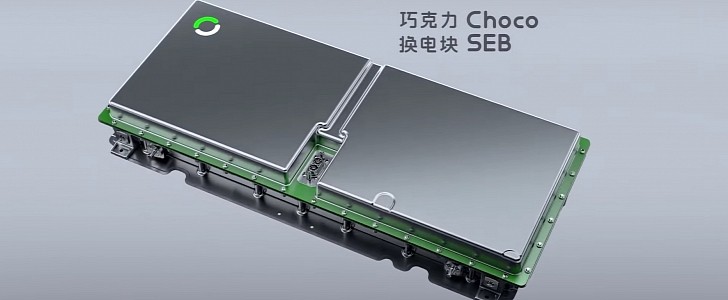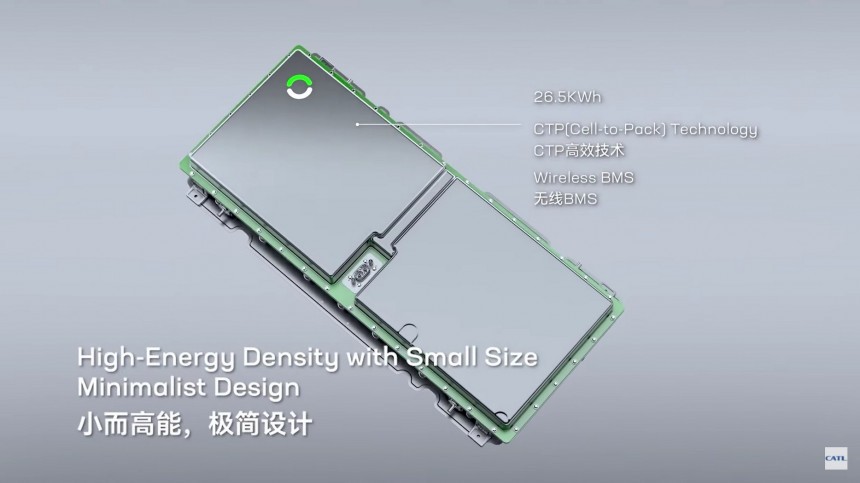On April 17, we told our readers how swappable battery modules could make a revolution in EV adoption. Little did we know that CATL would officially kick off its EVOGO service the following day in Xiamen, China. For those that did not read our article about this idea in January, it involves precisely the swappable battery modules we were talking about.
To be more specific, CATL announced at the beginning of the year that it will call its battery modules Choco-SEBs. They are made of LFP cells, and each module offers 26.5 kWh. In the first car to adopt them – the Bestune NAT taxi cab – one module offers around 200 kilometers (124 miles) of range. Thanks to the CTP (cell-to-pack) construction method, the Choco-SEBs have an energy density above 160 Wh/kg and a volume energy density of 325 Wh/l.
CATL started operating four swapping stations at once in Xiamen. By the end of 2022, the battery manufacturer intends to have 30 stating on the island, allowing all users to find them within 3 km (1.9 mi). Each station occupies a space equivalent to three parking spots and can hold 48 Choco-SEBs. The Chinese cell producer said it wants to spread them to eight Chinese cities soon.
The deal with these swappable modules is that users can choose how many they want in their cars and pay for them accordingly. Currently, CATL will charge customers RMB399 ($62.7 at the current exchange rate) per month for each Choco-SEB.
An EV that uses three of them would end up paying RMB1,197 ($188) for 79.5 kWh. Compared to the RMB980 ($153.9) NIO charges per month for the 75-kWh BaaS (Battery as a Service) system, CATL is asking slightly more for kWh than NIO. However, the fact that customers can choose to use fewer modules can reduce their expenses. According to CATL, they can get more modules if they want to make a road trip, for example.
This is precisely the advantage we pointed out about swappable battery modules in our April 17 article. Customers that do not need massive battery packs for their daily needs can have just one to commute and only pay for the extra capacity when they actually need it, as someone that prefers not to fill up the fuel tanks in their cars. Unlike a combustion-engined vehicle, more energy in an EV represents much more mass than all fuel a tank can carry. A lighter EV can travel much further with the energy it has.
As a reader rightfully stressed, the handicap a smaller battery pack presents is that it will theoretically have a more severe usage than a large one. While a 79.5-kWh battery pack would not need to fully charge or discharge for the daily driving needs of a customer, a 26.5-kWh module could need 100% of the charge and reach 0% of capacity more frequently.
The good news is that this may not be the case for many reasons. First of all, because the module is swappable, which means the driver can decide to replace it whenever the charge is lower, spending only one minute in the process. CATL also addressed that with LFP cells on the Choco-SEBs, which prefer to be charged to 100% of capacity and are not prone to thermal runaway (catching fire) – unlike ternary batteries.
Finally, the battery packs do not belong to the drivers, which takes the worry about how robust they are from the customers to the companies that provide them. In other words, it is CATL that has to ensure they do not catch fire and last as much as possible.
After all, it is their investment going from EV to EV. The Chinese cell manufacturer seems pretty confident that EVOGO will speed up EV adoption. If more carmakers buy the idea, we can’t see why it wouldn’t.
CATL started operating four swapping stations at once in Xiamen. By the end of 2022, the battery manufacturer intends to have 30 stating on the island, allowing all users to find them within 3 km (1.9 mi). Each station occupies a space equivalent to three parking spots and can hold 48 Choco-SEBs. The Chinese cell producer said it wants to spread them to eight Chinese cities soon.
The deal with these swappable modules is that users can choose how many they want in their cars and pay for them accordingly. Currently, CATL will charge customers RMB399 ($62.7 at the current exchange rate) per month for each Choco-SEB.
This is precisely the advantage we pointed out about swappable battery modules in our April 17 article. Customers that do not need massive battery packs for their daily needs can have just one to commute and only pay for the extra capacity when they actually need it, as someone that prefers not to fill up the fuel tanks in their cars. Unlike a combustion-engined vehicle, more energy in an EV represents much more mass than all fuel a tank can carry. A lighter EV can travel much further with the energy it has.
As a reader rightfully stressed, the handicap a smaller battery pack presents is that it will theoretically have a more severe usage than a large one. While a 79.5-kWh battery pack would not need to fully charge or discharge for the daily driving needs of a customer, a 26.5-kWh module could need 100% of the charge and reach 0% of capacity more frequently.
Finally, the battery packs do not belong to the drivers, which takes the worry about how robust they are from the customers to the companies that provide them. In other words, it is CATL that has to ensure they do not catch fire and last as much as possible.
After all, it is their investment going from EV to EV. The Chinese cell manufacturer seems pretty confident that EVOGO will speed up EV adoption. If more carmakers buy the idea, we can’t see why it wouldn’t.
















